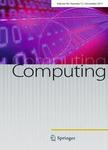版权所有:内蒙古大学图书馆 技术提供:维普资讯• 智图
内蒙古自治区呼和浩特市赛罕区大学西街235号 邮编: 010021

作者机构:Univ Hyderabad Sch Comp & Informat Sci Hyderabad Telangana India
出 版 物:《COMPUTING》 (Comput.)
年 卷 期:2024年第106卷第7期
页 面:2239-2259页
核心收录:
学科分类:08[工学] 0812[工学-计算机科学与技术(可授工学、理学学位)]
基 金:We are grateful to the anonymous reviewers for their valuable comments and suggestions which helped in improving the quality of this manuscript. The first author acknowledges the financial assistance received from the University Grants Commission (UGC), Go University Grants Commission (UGC), Government of India
主 题:Article recommendation Heterogeneous bibliographic networks HITS algorithm Attributed weighted networks
摘 要:Over the years the number of research publications per year is growing exponentially. Finding research papers of quality from the massive literature of relevant articles is a challenging and time-consuming task. The approaches in the latest literature address citation recommendation by utilizing large bibliographic information and use machine learning and deep learning methods for the task. These techniques clearly require a large amount of training data as well as machines with high processing power. To overcome these issues, we propose a novel method by modifying the popular hyperlink induced topic search (HITS), a web page ranking algorithm, as citation recommendation using hyperlink induced topic search (CR-HITS) that works on a directed and weighted heterogeneous bibliographic network containing diverse types of nodes and edges. We define effective scoring schemes for nodes and edges based on basic bibliographic information like citations of papers, number of publications of an author, etc. Given a few seed papers, the citation recommendation algorithm CR-HITS is run on small neighborhoods of the seed papers and hence the time taken by the execution is very small to yield the final recommendations. To the best of our knowledge, HITS has been used for the first time for the citation recommendation problem. We perform extensive experimentation on DBLP (version-11) and ACM (version-9) datasets and compare the results with many baseline methods in terms of MAP, MRR, and recall@N measures. The performance of the proposed algorithms is superior with respect to the MAP metric and matches the second best for the other two metrics. Since the top two algorithms use deep learning methods and use much larger bibliographic information including abstracts of the papers, we claim that our approach utilizes very low resources, yet yields recommendations that are very close to the top recommendations.